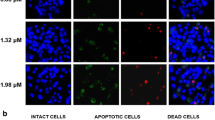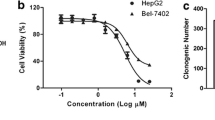Abstract
Momordin Ic is a natural triterpenoid saponin enriched in various Chinese and Japanese natural medicines such as the fruit of Kochia scoparia (L.) Schrad. So far, there is little scientific evidence for momordin Ic with regard to the anti-tumor activities. The aim of this work was to elucidate the anti-tumor effect of momordin Ic and the signal transduction pathways involved. We found that momordin Ic induced apoptosis in human hepatocellular carcinoma HepG2 cells, which were supported by DNA fragmentation, caspase-3 activation and PARP cleavage. Meanwhile, momordin Ic triggered reactive oxygen species (ROS) production together with collapse of mitochondrial membrane potential, cytochrome c release, down-regulation of Bcl-2 and up-regulation of Bax expression. The activation of p38 and JNK, inactivation of Erk1/2 and Akt were also demonstrated. Although ROS production rather than NO was stimulated, the expression of iNOS and HO-1 were altered after momordin Ic treatment for 4 h. Furthermore, the cytochrome c release, caspase-3 activation, Bax/Bcl-2 expression and PARP cleavage were promoted with LY294002 and U0126 intervention but were blocked by SB203580, SP600125, PI3K activator, NAC and 1,400 W pretreatment, demonstrating the mitochondrial disruption. Furthermore, momordin Ic combination with NAC influenced MAPK, PI3K/Akt and HO-1, iNOS pathways, MAPK and PI3K/Akt pathways also regulated the expression of HO-1 and iNOS. These results indicated that momordin Ic induced apoptosis through oxidative stress-regulated mitochondrial dysfunction involving the MAPK and PI3K-mediated iNOS and HO-1 pathways. Thus, momordin Ic might represent a potential source of anticancer candidate.













Similar content being viewed by others
References
Fattovich G, Stroffolini T, Zagni I, Donato F (2004) Hepatocellular carcinoma in cirrhosis: incidence and risk factors. Gastroenterology 127:35–50
Okuda K (2000) Hepatocellular carcinoma. J Hepatol 32:225–237
Ma S, Jiao B, Liu X, Yi H, Kong D, Gao L, Zhao G, Yang Y, Liu X (2010) Approach to radiation therapy in hepatocellular carcinoma. Cancer Treat Rev 36:157–163
Sloviter RS (2002) Apoptosis: a guide for the perplexed. Trends Pharmacol Sci 23:19–24
Nicholson KM, Anderson NG (2002) The protein kinase B/Akt signalling pathway in human malignancy. Cell Signal 14:381–395
Robinson MJ, Cobb MH (1997) Mitogen-activated protein kinase pathways. Curr Opin Cell Biol 9:180–186
Yang XR, Wang YY, La KK, Peng L, Song XH, Shi XG, Zhu XF, Leung PC, Ko CH, Ye CX (2012) Inhibitory effects of cocoa tea (Camellia ptilophylla) in human hepatocellular carcinoma HepG2 in vitro and in vivo through apoptosis. J Nutr Biochem 23:1051–1057
Gong K, Li W (2011) Shikonin, a Chinese plant-derived naphthoquinone, induces apoptosis in hepatocellular carcinoma cells through reactive oxygen species: a potential new treatment for hepatocellular carcinoma. Free Radic Biol Med 51:2259–2271
Chan KT, Meng FY, Li Q, Ho CY, Lam TS, To Y, Lee WH, Li M, Chu KH, Toh M (2010) Cucurbitacin B induces apoptosis and S phase cell cycle arrest in BEL-7402 human hepatocellular carcinoma cells and is effective via oral administration. Cancer Lett 294:118–124
Matsuda H, Li Y, Yoshikawa M (1999) Roles of capsaicin-sensitive sensory nerves, endogenous nitric oxide, sulfhydryls, and prostaglandins in gastroprotection by momordin Ic, an oleanolic acid oligoglycoside, on ethanol-induced gastric mucosal lesions in rats. Life Sci 65:27–32
Matsuda H, Li Y, Yamahara J, Yoshikawa M (1999) Inhibition of gastric emptying by triterpene saponin, momordin Ic, in mice: roles of blood glucose, capsaicin-sensitive sensory nerves, and central nervous system. J Pharmacol Exp Ther 289:729–734
Li Y, Matsuda H, Yamahara J, Yoshikawa M (2000) Acceleration of gastrointestinal transit by momordin Ic in mice: possible involvement of 5-hydroxytryptamine, 5-HT(2) receptors and prostaglandins. Eur J Pharmacol 392:71–77
Kim NY, Lee MK, Park MJ, Kim SJ, Park HJ, Choi JW, Kim SH, Cho SY, Lee JS (2005) Momordin Ic and oleanolic acid from Kochiae Fructus reduce carbon tetrachloride-induced hepatotoxicity in rats. J Med Food 8:177–183
Mosmann T (1983) Rapid colorimetric assay for cellular growth and survival: application to proliferation and cytotoxicity assays. J Immunol Methods 65:55–63
Nie F, Zhang X, Qi Q, Yang L, Yang Y, Liu W, Lu N, Wu Z, You Q, Guo Q (2009) Reactive oxygen species accumulation contributes to gambogic acid-induced apoptosis in human hepatoma SMMC-7721 cells. Toxicology 260:60–67
Wang QS, Zheng YM, Dong L, Ho YS, Guo Z, Wang YX (2007) Role of mitochondrial reactive oxygen species in hypoxia-dependent increase in intracellular calcium in pulmonary artery myocytes. Free Radic Biol Med 42:642–653
Koo HN, Hong SH, Seo HG, Yoo TS, Lee KN, Kim NS, Kim CH, Kim HM (2003) Inulin stimulates NO synthesis via activation of PKC-α and protein tyrosine kinase, resulting in the activation of NF-κB by IFN-γ-primed RAW 264.7 cells. J Nutr Biochem 14:598–605
Baskić D, Popović S, Ristić P, Arsenijević NN (2006) Analysis of cycloheximide-induced apoptosis in human leukocytes: fluorescence microscopy using annexin V/propidium iodide versus acridin orange/ethidium bromide. Cell Biol Int 30:924–932
Johnson GL, Lapadat R (2002) Mitogen-activated protein kinase pathways mediated by ERK, JNK and p38 protein kinases. Science 298:1911–1912
Maines MD, Gibbs PE (2005) 30 Some years of heme oxygenase: from a “molecular wrecking ball” to a “mesmerizing” trigger of cellular events. Biochem Biophys Res Commun 338:568–577
Kikuchi G, Yoshida T, Noguchi M (2005) Heme oxygenase and heme degradation. Biochem Biophys Res Commun 338:558–567
Li Q, Li W, Hui LP, Zhao CY, He L, Koike K (2012) 13,28-Epoxy triterpenoid saponins from Ardisia japonica selectively inhibit proliferation of liver cancer cells without affecting normal liver cells. Bioorg Med Chem Lett 22:6120–6125
Yu L, Wang X, Wei X, Wang M, Chen L, Cao S, Kang N, Qiu F (2012) Triterpenoid saponins from Xanthoceras sorbifolia Bunge and their inhibitory activity on human cancer cell lines. Bioorg Med Chem Lett 22:5232–5238
Yin Y, Chen W, Tang C, Ding H, Jang J, Weng M, Cai Y, Zou G (2011) NF-κB, JNK and p53 pathways are involved in tubeimoside-1-induced apoptosis in HepG2 cells with oxidative stress and G2/M cell cycle arrest. Food Chem Toxicol 49:3046–3054
Zhao YY, Chao X, Zhang Y, Sun LJ, Zhang H, Lin RC, Shen X, Sun WJ (2010) Cytotoxic activities of tubeimoside-2 on human hepatoma HepG2 cells by induction of G2/M phase arrest and apoptosis in a p53-dependent manner. Apoptosis 15:1549
Han J, Jogie-Brahim S, Harada A, Oh Y (2011) Insulin-like growth factor-binding protein-3 suppresses tumor growth via activation of caspase-dependent apoptosis and cross-talk with NF-κB signaling. Cancer Lett 307:200–210
Nagaraj NS, Anilakumar KR, Singh OV (2010) Diallyl disulfide causes caspase-dependent apoptosis in human cancer cells through a Bax-triggered mitochondrial pathway. J Nutr Biochem 21:405–412
Dewson G, Kluck RM (2009) Mechanisms by which Bak and Bax permeabilise mitochondria during apoptosis. J Cell Sci 122:2801–2808
Teijido O, Dejean L (2010) Upregulation of Bcl-2 inhibits apoptosis-driven BAX insertion but favors BAX relocalization in mitochondria. FEBS Lett 584:3305–3310
Bartosz G (2009) Reactive oxygen species: destroyers or messengers? Biochem Pharmacol 77:1303–1315
Circu ML, Aw TY (2010) Reactive oxygen species, cellular redox systems, and apoptosis. Free Radic Biol Med 48:749–762
Fleury C, Mignotte B, Vayssière JL (2002) Mitochondrial reactive oxygen species in cell death signaling. Biochimie 84:131–141
Higuchi Y (2003) Chromosomal DNA fragmentation in apoptosis and necrosis induced by oxidative stress. Biochem Pharmacol 66:1527–1535
Bonavida B, Baritaki S (2011) Dual role of NO donors in the reversal of tumor cell resistance and EMT: downregulation of the NF-κB/Snail/YY1/RKIP circuitry. Nitric Oxide 24:1–7
Szanto A, Hellebrand EE, Bognar Z, Tucsek Z, Szabo A, Gallyas FJ, Sumegi B, Varbiro G (2009) PARP-1 inhibition-induced activation of PI-3-kinase-Akt pathway promotes resistance to taxol. Biochem Pharmacol 77:1348–1357
Xing H, Weng D, Chen G, Tao W, Zhu T, Yang X, Meng L, Wang S, Lu Y, Ma D (2008) Activation of fibronectin/PI3K/Akt leads to chemoresistance to docetaxel by regulating survivin protein expression in ovarian and breast cancer cells. Cancer Lett 261:108–119
Xia Z, Dickens M, Raingeaud J, Davis RJ, Greenberg ME (1995) Opposing effects of ERK and JNK-p38MAP kinases on apoptosis. Science 270:1326–1331
Min L, He B, Hui L (2011) Mitogen-activated protein kinases in hepatocellular carcinoma development. Semin Cancer Biol 21:10–20
Mayerhofer M, Florian S, Krauth MT, Aichberger KJ, Bilban M, Marculescu R, Printz D, Fritsch G, Wagner O, Selzer E, Sperr WR, Valent P, Sillaber C (2004) Identification of heme oxygenase-1 as a novel BCR/ABL-dependent survival factor in chronic myeloid leukemia. Cancer Res 64:3148–3154
Fang J, Sawa T, Akaike T, Akuta T, Sahoo SK, Khaled G, Hamada A, Maeda H (2003) In vivo antitumor activity of pegylated zinc protoporphyrin: targeted inhibition of heme oxygenase in solid tumor. Cancer Res 63:567–3574
Doi K, Akaike T, Fujii S, Tanaka S, Ikebe N, Beppu T, Shibahara S, Ogawa M, Maeda H (1999) Induction of haem oxygenase-1 by nitric oxide and ischaemia in experimental solid tumours and implications for tumour growth. Br J Cancer 80:945–1954
Fang J, Sawa T, Akaike T, Greish K, Maeda H (2004) Enhancement of chemotherapeutic response of tumor cells by a heme oxygenase inhibitor, pegylated zinc protoporphyrin. Int J Cancer 109:1–8
Fang J, Akaike T, Maeda H (2004) Antiapoptotic role of heme oxygenase (HO) and the potential of HO as a target in anticancer treatment. Apoptosis 9:27–35
Sawa T, Mounawar M, Tatemichi M, Gilibert I, Katoh T, Ohshima H (2008) Increased risk of gastric cancer in Japanese subjects is associated with microsatellite polymorphisms in the heme oxygenase-1 and the inducible nitric oxide synthase gene promoters. Cancer Lett 269:78–84
Doi K, Akaike T, Fujii S, Ikebe N, Beppu T, Ogawa M, Maeda H (2003) Heme oxygenase and nitric oxide synthase on tumor growth. Int Congr Ser 1255:265–268
Hoetzel A, Welle A, Schmidt R, Loop T, Humar M, Ryter SW, Geiger KK, Choi AM, Pannen BH (2008) Nitric oxide-deficiency regulates hepatic heme oxygenase-1. Nitric Oxide 18:61–69
Acknowledgments
This work was supported by the Young Scientists Fund of the National Natural Science Foundation of China (Grant No. 31000757).
Conflict of Interest
The authors declare that they have no conflict of interest.
Author information
Authors and Affiliations
Corresponding author
Rights and permissions
About this article
Cite this article
Wang, J., Yuan, L., Xiao, H. et al. Momordin Ic induces HepG2 cell apoptosis through MAPK and PI3K/Akt-mediated mitochondrial pathways. Apoptosis 18, 751–765 (2013). https://doi.org/10.1007/s10495-013-0820-z
Published:
Issue Date:
DOI: https://doi.org/10.1007/s10495-013-0820-z




